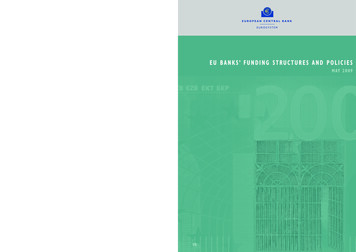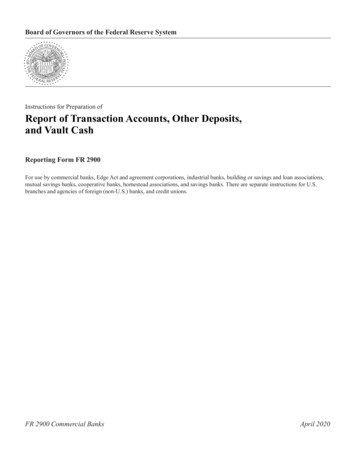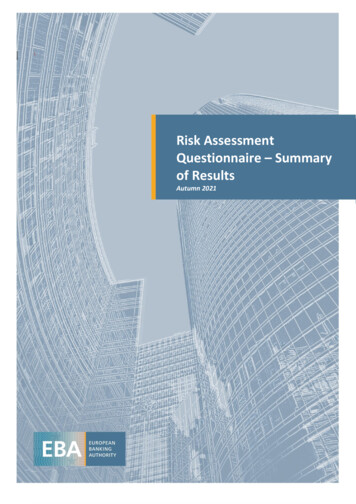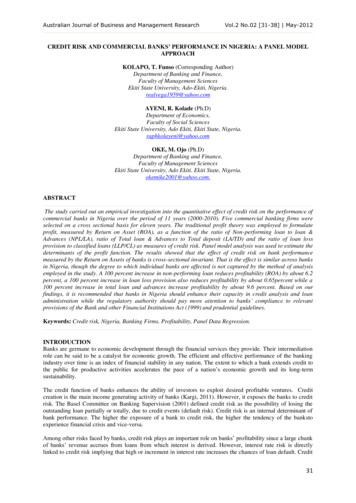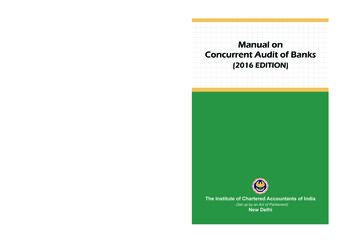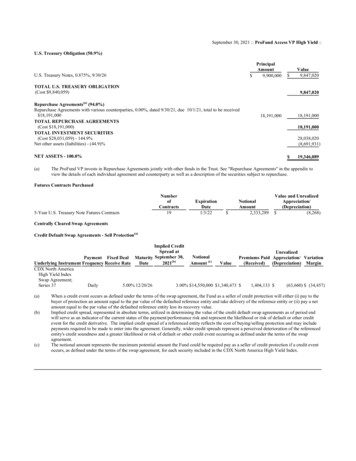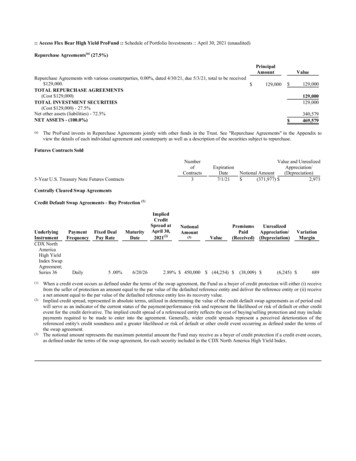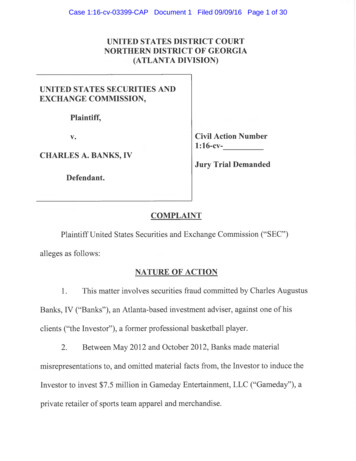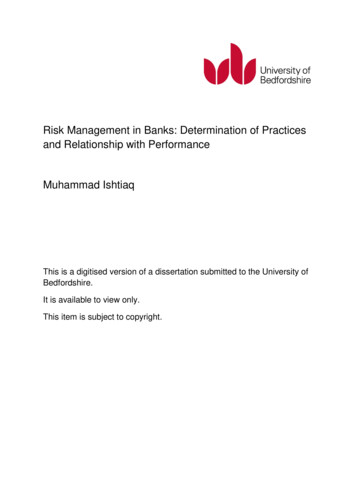
Transcription
Risk Management in Banks: Determination of Practicesand Relationship with PerformanceMuhammad IshtiaqThis is a digitised version of a dissertation submitted to the University ofBedfordshire.It is available to view only.This item is subject to copyright.
RISK MANAGEMENT IN BANKS:DETERMINATION OF PRACTICES ANDRELATIONSHIP WITH PERFORMANCEMUHAMMAD ISHTIAQPhD2015UNIVERSITY OF BEDFORDSHIRE
Risk Management in Banks: Determination ofPractices and Relationship with PerformanceByMuhammad IshtiaqA thesis submitted to the University of Bedfordshire in partial fulfilment ofthe requirements for the degree of Doctor of PhilosophyMarch 2015
DedicationTo my loving parents, caring brother, beloved wife, lovely children andother family members for supporting me to find the strength within andfor giving me the confidence to attain this goal.You all are great blessings of Allah and the joy of my life.I
RISK MANAGEMENT IN BANKS: DETERMINATION OF PRACTICESAND RELATIONSHIP WITH PERFORMANCEMUHAMMAD ISHTIAQAbstractThe issue of risk management in banks has become the centre of debate after therecent financial crises. Several efforts have been made to improve the riskmanagement and performance of banks including introducing the Basel Accords aswell as risk management guidelines by central banks. Consequently, the State Bankof Pakistan has issued risk management guidelines to strengthen the riskmanagement system and to improve the performance of the local banks. However,the available literature in Pakistani context fails to explain the impact of theseefforts on the performance of banks. The purpose of this study is to empiricallyexamine the effectiveness of risk management processes and their relationship withthe performance of banks. This study reviews the relevant literature on banking riskmanagement from diverse methodological strands and synthesises its conclusionsto make an addition to the available knowledge; particularly to address certainresearch gaps regarding risk management and performance of banks in developingcountries, specifically in Pakistan.Owing to its empirical nature, the current research adopts a deductive reasoningapproach in terms of theory testing. This study applies a mixed method researchstrategy by taking the quantitative method as the major component, while thequalitative method plays a supplementary role. The sample is composed of twentybanks in Pakistan and the stratification is performed according to the bank category(public, private and foreign) in respect of different strata. The study collects andanalyses primary as well as secondary data. This research is carried out in threephases. In the first phase a qualitative system dynamics model (Causal LoopDiagram) is developed based upon interview data analysis to understand andII
document the behaviour of risk management systems of Pakistani banks. In thesecond phase, this research conducts questionnaire data analysis by using ordinaryleast-squares regression to assess the different aspects risk management practicesof banks in Pakistan. Finally, two-stage data envelopment analysis technique hasbeen adopted to examine the relationship between the risk management andperformance of the selected banks.This study results reflect that it is very important for Pakistani banks to formulatean active risk management process to identify, measure, monitor and controldifferent risks. These results further reveal that formation of a comprehensive riskmanagement system is not only a useful practice to meet the regulatoryrequirements but an effective exercise to improve the performance of Pakistanibanks also. By employing a pragmatic, embedded, mixed method research strategy,this study has created a new insight into risk management in local banks and extendsthe existing theoretical literature in the field of banking in various ways.III
AcknowledgementsFirst of all, I thank Almighty Allah, the Most Merciful and the Most Gracious, Whogave me the courage and patience to achieve this milestone.I am indebted to my Director of Studies Professor Michael Kennedy for his patientguidance, encouragement and endless support. Michael always spared his valuabletime for corrections and comments on my research work, right from day one till theend of this study. His guidance and suggestions have brought substantialimprovement in my work. I am also very thankful to other members of mysupervisory team, Dr Syamarlah Rasaratnam and Dr Socrates Karidis, for theirinvaluable advices and suggestions during the process of this research.I would also like to thank my dear colleague Muhammad Shahid Tufail who alwayshelped me like a real brother. His advice, encouragement and support inspired methrough difficult times.My deepest and sincere gratitude to my family for their prayers and patience. I amhopeful that this work and degree would pay all of their sacrifices.Finally, I want to say thank to everyone who helped me during the course of thisstudy.IV
DeclarationI declare that this thesis is my own unaided work. It is being submitted for thedegree of PhD, at the University of Bedfordshire.It has not been submitted before for any degree or examination in any otherUniversity.Signature:Muhammad IshtiaqDate: 04 November, 2015V
Table of ContentsDedication . IAbstract . IIAcknowledgements . IVDeclaration .VList of Tables. XIIList of Figures . XIIIList of Abbreviations.XIVChapter One Introduction and Context of Study . 11.1 Introduction . 11.2 Background of the Study . 11.2.1 Pakistan Banking System .21.2.1.1 State Bank of Pakistan.21.2.1.2 Scheduled Banks Operating in Pakistan .41.2.2 Risk Management in Pakistani Banks .61.2.3 Risk Management and Performance in Pakistani Banks .81.3 Aim and Objectives of the Study. 91.4 Research Questions . 101.5 Rational and Significance of the Study . 101.6 General Outline of Research Methodology . 131.7 Structure of the Thesis . 15Chapter Two Lite rature Review . 182.1 Introduction . 182.2 Definition, Functions and Roles of Banks. 182.3 Risk in Banking . 202.3.1 Types of Risks in Banks. 212.4 Risk Management in Banks . 272.4.1 Rationales for Risk Management in Banks . 292.4.1.1 Financial Economics Approach. 292.4.1.2 Institutional Theory. 302.4.1.3 Agency Theory . 312.4.1.4 Stakeholder Theory . 322.4.2 Risk Management and Basel Accords . 33VI
2.5 Risk Management in Pakistani Banks . 362.5.1 Risk Management Guidelines . 362.5.1.1 General Requirements . 372.5.1.2 Guidelines on Credit Risk. 382.5.1.3 Guidelines on Market Risk . 392.5.1.4 Guidelines on Liquidity Risk . 402.5.1.5 Guidelines on Operational Risk. 402.6 Previous Research on Risk Management Practices of Banks . 412.7 Risk Management and Performance. 492.7.1 Measuring the Performance of Banks. 602.8 Research Gap . 672.9 Summary. 70Chapter Three Research Methodology . 713.1 Introduction . 713.2 Research Philosophy . 713.2.1 Epistemological Considerations . 723.2.2 Ontological Considerations . 743.2.3 Research Philosophy of this Study . 753.3 Research Approach. 763.3.1 Research Approach of the Study. 783.4 Research Strategy . 783.4.1 Research Strategy of the Study . 823.5 Research Design . 833.5.1 Study Research Design . 863.6 Study Time Horizon . 893.7 Research Population and Sampling . 893.7.1 Study Population . 893.7.2 Sampling Procedures . 903.8 Primary Data Collection and Analysis Procedures . 943.8.1 Interviews . 943.8.2 Questionnaires . 963.8.2.1 Questionnaire Design (Format) . 983.8.2.2 Operationalization. 100VII
3.8.2.3 Pilot Study . 1043.8.2.4 Data Collection through Main Questionnaire Survey . 1063.8.2.5 Response Rate . 1073.8.2.6 Analysis Techniques for Questionnaire Data. 1083.8.2.6.1 Descriptive statistics . 1083.8.2.6.2 Reliability or Internal Consistency of Variables . 1083.8.2.6.3 Multicollinearity. 1103.8.2.6.4 Pearson Correlation . 1123.8.2.6.5 Multiple Regression Analysis . 1133.8.2.7 Validity Analysis for Survey Questionnaire Phase. 1143.8.2.7.1 Measurement (Content) Validity . 1143.8.2.7.2 Statistical Validity . 1143.9 Secondary Data Collection and Analysis Procedures . 1153.9.1 Secondary Data Collection for this Study . 1163.9.2 Secondary Data Analysis Procedures . 1173.9.2.1 Data Envelopment Analysis . 1183.9.2.1.1 The CRS Model . 1183.9.2.1.2 The VRS Model . 1213.9.2.1.3 Inputs and Outputs Specification . 1223.9.2.2 Tobit Regression Analysis . 1253.10 Gathering Third Parties (Non-Respondents) Information . 1263.11 Summary. 126Chapter Four Qualitative System Dynamics Model of the Risk ManagementSystem of Pakistani Banks. 1284.1 Introduction . 1284.2 Systems Thinking . 1284.3 Interviews Data Collection . 1364.3.1 Interview Participants . 1384.4 Interview Data Analysis and Results. 1394.4.1 Clarity of the Diagram . 1404.4.2 Logical Structure of the Diagram. 1414.2.3 Practical Relevance of the Diagram . 1424.2.4 Comprehensiveness of the Diagram . 1434.2.5 Intelligibility of the Diagram . 144VIII
4.2.6 Applicability of the Diagram . 1454.2.7 Diagram’s Points of Weakness . 1464.2.8 Diagram’s Point of Strength . 1474.2.9 Portrayed Accuracy of the Diagram . 1484.2.10 Suitability of Casual Relationships between the Variables . 1504.5 Final Casual Loop Diagram of the Risk Management System of PakistaniBanks . 1514.5.1 Managing Operational Risk. 1514.5.2 Managing Credit Risk . 1544.5.3 Managing Liquidity Risk . 1564.5.4 Managing Market Risk . 1584.5.5 Identification of Key Variables. 1614.6 Summary. 162Chapter Five Different Aspects of Risk Management in Pakistani Banks 1635.1 Introduction . 1635.2 Research Instrument . 1645.3 Descriptive Statistics Analysis . 1655.3.1 Descriptive Analysis for Study Variables . 1675.3.1.1 Risk Understanding. 1675.3.1.2 Risk Identification . 1695.3.1.3 Risk Assessment and Analysis . 1705.3.1.4 Risk Monitoring and Controlling . 1715.3.1.5 Managing Credit Risk . 1735.3.1.6 Managing Market Risk . 1745.3.1.7 Managing Liquidity Risk . 1745.3.1.8 Managing Operational Risk . 1755.3.1.9 Risk Management Practices . 1765.3.2 Different Types of Risks and Methods for Risk Management . 1785.4 Relationship between Risk Management Practices and Different Aspects ofRisk Management (Study Hypotheses) . 1815.4.1 Testing of Association among Study Variables (Correlation Analysis) . 1825.4.2 Testing of Relationship between Risk Management Practices and DifferentAspects of Risk Management (Regression Analysis) . 1845.5 Discussion of Results . 186IX
5.5.1 Relationship between Risk Und and Risk MgtPrcs. 1865.5.2 Relationship between Risk Ident and Risk MgtPrcs. 1875.5.3 Relationship between Risk AA and Risk MgtPrcs. 1885.5.4 Relationship between Risk MC and Risk MgtPrcs . 1885.5.5 Relationship between Mag CrRisk and Risk MgtPrcs. 1895.5.6 Relationship between Mag MktRisk and Risk MgtPrcs . 1905.5.7 Relationship between Mag LqutRisk and Risk MgtPrcs . 1915.5.8 Relationship between Mag OptRisk and Risk MgtPrcs. 1925.5.9 Identification of Key Variables. 1925.6 Summary. 193Chapter SixRisk Management and Performance . 1946.1 Introduction . 1946.2 Performance of Banks . 1956.3 Relationship between Risk Management and Performance (StudyHypothesis) . 1966.3.1 Performance of Banks (Dependent Variable) . 1976.3.2 Risk Management (Independent Variables) . 1976.3.2.1 Managing Operational Risk . 1976.3.2.2 Managing Credit Risk . 1986.3.2.3 Managing Liquidity Risk . 2006.3.2.4 Managing Market Risk . 2016.3.3 Testing of Relationship between Risk Management and Performance . 2046.4 Discussion of Results . 2066.5 Summary. 210Chapter SevenConclusion . 2117.1 Introduction . 2117.2 Risk Management Practices and Performance of Banks . 2117.3 Conduct of Research. 2137.4 Summary of Key Findings. 2147.4.1 Qualitative System Dynamics Model of the Risk Management System ofPakistani Banks . 2157.4.2 Different Aspects of Risk Management in Pakistani Banks . 2167.4.3 Relationship between Risk Management and Performance in Pakistani Banks. 218X
7.5 Contribution of Research. 2197.5.1 Methodological Contributions . 2197.5.2 Theoretical Contributions. 2207.5.3 Practical Contributions . 2217.6 Limitations of Research. 2227.7 Recommendations of Future Prospects . 2247.8 Final Conclusion. 226References . 227Appendices . 252Appendix One: List of the study population banks . 252Appendix Two: Consent form for survey research . 253Appendix Three: Reference letter for data collection . 263Appendix Four: Interview schedule . 264Appendix Five: Technical Efficiency Scores . 268XI
List of eTableTableTableTableTable2.1: Performance measurement techniques applied in the different studies3.1: Deduction, induction: from reason to research .3.2: Use of mixed method research in different fields .3.3: Reasons for using a mixed methods design .3.4: List of selected banks for the study .3.5: Share of selected banks in the population .3.6: Description of five point Likert scale for assessing responses .3.7: Operationalization of the study variables .3.8: Reliability analysis of study variables based on pilot study data .3.9: Reliability analysis of study variables .3.10: Multicollinearity test results 3.11: Different inputs and outputs specifications of previous studies .4.1: List of interview questions 4.2: Demographics characteristics of the interviews participants 5.1: Demographical characteristics of questionnaire respondents .5.2: Participants’ responses on risk understanding .5.3: Participants’ responses on risk identification 5.4: Participants’ responses on risk assessment and analysis .5.5: Participants’ responses on risk monitoring and controlling .5.6: Participants’ responses on managing credit risk .5.7: Participants’ responses on managing market risk .5.8: Participants’ responses on managing liquidity risk .5.9: Participants’ responses on managing operational risk .5.10: Participants’ responses on risk management practices 5.11: Different types of risks in Pakistan .5.12: The top five most important risks 5.13: Variables included in analysis .5.14: Correlation Matrix .5.15: Results of multiple regression analysis .6.1: Summary statistics of second stage variables .6.2: Tobit regression analysis results A-1: Descriptive statistics: inputs and outputs .A-2: Technical efficiency scores .A-3: Mean efficiency scores of the different categories of banks 70172173174175176177178179182183185204205268270271
List of FiguresFigure 1.1: Functions of SBP . .Figure 1.2: Functions of commercial banks in Pakistan .Figure 1.3: Structure of the thesis .Figure 3.1: The process of deduction .Figure 3.2: Classifying mixed methods research in terms of priority andsequence .Figure 3.3: Study research design Figure 3.4: Sampling techniques Figure 3.5: Interview categories .Figure 3.6: Types of questionnaire .Figure 4.1: Reinforcing feedback loop .Figure 4.2: Balancing feedback loop .Figure 4.3: Preliminary causal loop diagram of the risk management system ofPakistani banks based upon the literature . Figure 4.4: Clarity of the diagram .Figure 4.5: Logical structure of the diagram .Figure 4.6: Practical relevance of the diagram .Figure 4.7: Comprehensiveness of the diagram .Figure 4.8: Intelligibility of the diagram Figure 4.9: Applicability of the diagram Figure 4.10: Portrayed accuracy of the diagram . .Figure 4.11: Suitability of casual relationships between the variables .Figure 4.12: Managing Operational Risk .Figure 4.13: Managing Credit Risk Figure 4.14: Managing liquidity risk .Figure 4.15: Managing market risk Figure 4.16: Final causal loop diagram of the risk management system ofPakistani banks . .Figure 5.1: Important methods and techniques for risk management Figure A-1: Mean efficiency scores of the different categories of banks for theyear 2005-2012 149150151155157158160180271
List of BLMCBNBPNIBRBISBLSBPSCBPLSDSFASPSSUBLVIFVRSAllied Bank LimitedAsian Development BankAskari Bank LimitedBank Al Habib LimitedBank Alfalah LimitedBanker, Charnes and CooperBasel Committee on Banking SupervisionThe Bank of KhyberThe Bank of PunjabThe Bank of Tokyo-Mitsubishi UFJ Limited - Pakistan OperationsCitibank N.A. - Pakistan OperationsCausal Loop DiagramCausal Loop DiagramsConstant Returns to ScaleDeutsche Bank AG - Pakistan OperationsData Envelopment AnalysisData Envelopment Analysis ProgramDecision Making UnitDecision Making UnitsFaysal Bank LimitedHabib Bank LimitedHSBC Bank Middle East Limited - Pakistan OperationsInstitute of Bankers PakistanInternational Monetary FundKASB Bank LimitedMeezan Bank LimitedMCB Bank LimitedNational Bank of PakistanNIB Bank LimitedReserve Bank of IndiaSoneri Bank LimitedState Bank of PakistanStandard Chartered Bank (Pakistan) LimitedStandard DeviationStochastic Frontier AnalysisStatistical Package for Social SciencesUnited Bank LimitedVariance Inflation FactorVariable Returns to ScaleXIV
Chapter OneIntroduction and Context of Study1.1 IntroductionThis chapter intends to provide an overview of this research. It describes estions,rational andsignificance of this study. It also provides an overview of the methodology that isundertaken during the course of this research in order to drawing the finalconclusions. Finally, the current chapter presents an outline of this thesis’sstructure.1.2 Background of the StudyPakistan is considered to be the second largest economy of the South Asiaregion (Shafiq and Nasr, 2010). The services sector plays a key role to augment the
RISK MANAGEMENT IN BANKS: DETERMINATION OF PRACTICES AND RELATIONSHIP WITH PERFORMANCE MUHAMMAD ISHTIAQ Abstract The issue of risk management in banks has become the centre of debate after the recent financial crises. Several efforts have been made to improve the risk management and performance of banks including introducing the Basel Accords .
